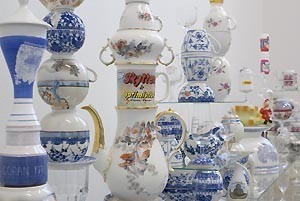
From the Studio of Elisabeth Westerlund, 2005 Photo: Åsa Lundén/Moderna Museet
What disappeared and what was left behind
Some ten years ago, she created her first Versailles (1993) in an empty one bedroom flat in Södermalm, Stockholm. It was a very astute installation, a reconstruction of Le Nôtre’s symmetrical plan for the promotion of the Sun King. Instead of pruned hedges and baroque sculptures, the plan’s outlines were marked by various types of kitchen utensils. The bird’s-eye view of the autocrat was replaced by the mocking gaze of the kitchen maid – high and low, monument and anti-monument. Five years later, she relayed the plan in the symmetrical 19th century building of Västerås Konstmuseum, with its symbolic history as a city hall. In this instance, her housekeeping was more fastidious and comprised utensils borrowed from family and friends, without, however, any personal references – they were the kind of mass-produced objects that we all possess. The contrast between the King’s territory and Elisabeth Westerlund’s mapping was tangible and comic, but at the same time, one was laughing on the other side of one’s face. If, in his time, Louis XIV had the preferential right of interpretation, who has it today?
Hoppsan [Oops] was the expressive title of Elisabeth Westerlund’s exhibition at Enkehuset, Stockholm, 1996, when she made a complete architectural somersault: a model of the Prague City Theatre was turned inside out, and placed upside down under an overturned glass table. It was a maliciously gleeful critique of lofty but unsubstantial ambitions, and a distorted reflection of the sacral history of the exhibition space. Alice had just paid a visit from Wonderland – her hair hanging through the ceiling and out of the mirror. She was in between the two sides of the mirror, in between our world and the world below.
The inverted perspective, high and low, and the comical coincidence of two seemingly incompatible worlds, is the doubled theme that runs through Elisabeth Westerlund’s work. In 2002, she showed the installation Bit för bit [Piece by Piece] at Skulpturens Hus, Stockholm. In the great ceremonial hall with its ten-metre high ceiling, she created an intricate pattern by dropping candle wax. Cotton buds and cheese doodles crowned the preparation, which resembled a giant spettekaka . It was a piece of bobbin-lace architecture.
Hearth and home inevitably conjure up images of Laura Ashley and her eternal flower patterns. Elisabeth Westerlund took a piece of flowered wallpaper as the point of departure for her work Wall Flower (2001), upon which she pinned real petals, which slowly decayed. Corruptibility and ideals, nature and culture. This doubleness is also expressed in two works by Elisabeth Westerlund acquired by Moderna Museet last summer: a textile photograph and a knitted object. She has mounted pieces of photographs on material and glued on a circular yarn pattern and hey presto, the apparently insignificant rises to the surface and takes over the connotations of the original motive (Haga, Sweden’s period as a great power) – a kaleidoscopic pattern of piping possibilities. The yarn object appears to be caught in an eternal process of sinking through the floor; partly unravelled, the yarn twists itself out from the epicentre of the piece of knitting.
The aspect of time is crucial to Elisabeth Westerlund’s work. The 1st at Moderna is no exception. It is a construction of what we literally leave behind – dirty dishes, rejected cups and kettles – and at the same time, it is a slowly exposed image of what our memories contain: meals, coffee breaks, and conversations. The tangible and the experienced are weaved together, a place emerges, a topography where ‘A Sagittarius is an optimist’ rests on ornate liqueur glasses, crowned by the flowered lid of a sugar bowl. A balancing act is taking place above our heads. If we are not careful, we might, at least imaginarily, bump our heads. It is beautiful and also somewhat uncomfortable. We are separated from an accident by nothing more than a plate of glass. ‘Be careful,’ we say to our children. How thin, almost non-existent, the dividing line is between order and chaos, happiness and catastrophe. Elisabeth Westerlund pulls out the pin by quotidian means.
Ann-Sofi Noring
